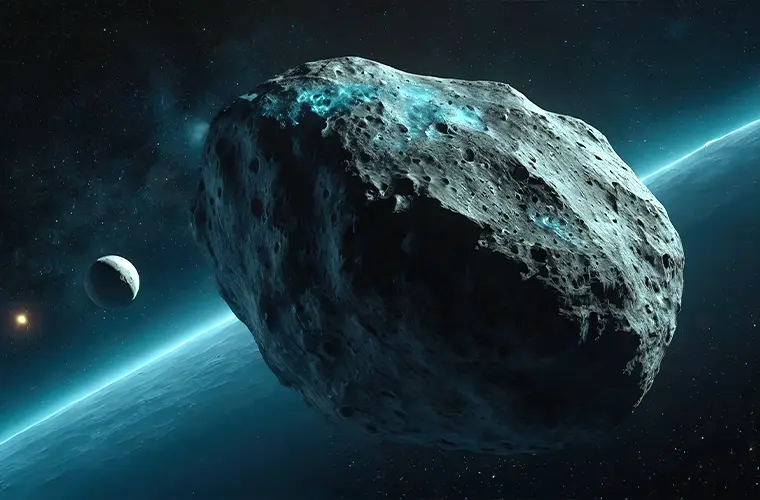A new study by researchers at the University of Michigan has revealed that mysterious asteroids known as “dark comets” may carry ice, suggesting these objects could have been a means of delivering water to Earth long ago.
The findings, recently published in the journal Icarus, open new avenues for understanding the origins of our planet’s water and the solar system’s evolution.
“We don’t know if these dark comets delivered water to Earth. We can’t say that. But we can say that there is still debate over how exactly the Earth’s water got here,” Aster Taylor, a graduate student in astronomy at the University of Michigan and lead author of the study, said in a statement. “The work we’ve done has shown that this is another pathway to get ice from somewhere in the rest of the solar system to the Earth’s environment.”
The origins of Earth’s water have long been a scientific debate. While some theories suggest that water was delivered to Earth by comets and asteroids, others propose that it was present from the planet’s formation. This new study adds another layer to this complex puzzle by highlighting a previously unconsidered source of water delivery: dark comets.
Dark comets are a unique and mysterious category of celestial bodies that combine characteristics of asteroids and comets. Unlike typical asteroids, which are rocky bodies orbiting close to the sun, or comets, which are icy bodies with visible comas (clouds of gas and dust), dark comets do not exhibit comas but display non-gravitational accelerations due to the sublimation of ice. As they approach the sun, the ice within them turns directly into gas, causing them to speed up slightly.
Taylor and his colleagues examined seven such dark comets and estimated that between 0.5% and 60% of all near-Earth objects could be dark comets.
Researchers used dynamical models to trace the paths of these dark comets over 100,000 years. They found that many of these objects ended up in their current positions from the main asteroid belt, suggesting it as their most likely origin.
One particularly interesting dark comet, 2003 RM, follows an elliptical orbit that takes it close to Earth, then out to Jupiter and back, mirroring the path of a Jupiter-family comet.
The study also explores why dark comets are typically small and rapidly rotating. As dark comets enter the inner solar system, the ice within them begins to sublimate, causing them to accelerate and spin faster. This rapid rotation can lead to the object breaking apart into smaller pieces, each continuing to lose ice and spin faster, further breaking into smaller fragments. This process results in the small, fast-rotating dark comets observed today.
“These pieces will also have ice on them, so they will also spin out faster and faster until they break into more pieces,” Taylor said. “You can just keep doing this as you get smaller and smaller and smaller. What we suggest is that the way you get these small, fast rotating objects is you take a few bigger objects and break them into pieces.”
This continuous fragmentation and ice sublimation process imply that the dark comets we see today are remnants of larger icy bodies from the asteroid belt. This finding supports the idea that the asteroid belt is not just a collection of dry, rocky objects but also harbors significant amounts of ice.
The implications of this study extend beyond understanding the origin of Earth’s water. It also sheds light on the dynamics of near-Earth objects and their potential threat to our planet. By studying dark comets, scientists can better predict the behavior of other near-Earth objects, improving our ability to mitigate potential impacts.
The discovery of dark comets also opens up new questions about the early solar system. How did these icy bodies form, and what role did they play in the evolution of planets? What other secrets does the asteroid belt hold, and how can they help us understand the history of our solar system?
Significantly, could dark comets provide water on alien worlds, and if so, how might this factor in our continued search for extraterrestrial life?
As researchers continue to study these enigmatic objects, the answers to these questions will undoubtedly provide valuable insights into the origins and evolution of our cosmic neighborhood. The study of dark comets is still in its early stages, but the potential for groundbreaking discoveries is immense.
Researchers’ findings also suggest that dark comets in our solar system likely originate from the asteroid belt, a region between Mars and Jupiter filled with rocky debris. If correct, the presence of ice in these mysterious objects indicates that the asteroid belt may contain more ice than previously thought.
“We think these objects came from the inner and/or outer main asteroid belt, and the implication of that is that this is another mechanism for getting some ice into the inner solar system,” Taylor noted. “There may be more ice in the inner main belt than we thought. There may be more objects like this out there. This could be a significant fraction of the nearest population.”
“We don’t really know, but we have many more questions because of these findings.”
Tim McMillan is a retired law enforcement executive, investigative reporter and co-founder of The Debrief. His writing typically focuses on defense, national security, the Intelligence Community and topics related to psychology. You can follow Tim on Twitter: @LtTimMcMillan. Tim can be reached by email: tim@thedebrief.org or through encrypted email: LtTimMcMillan@protonmail.com

